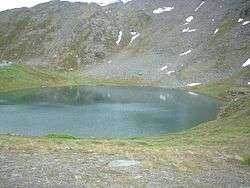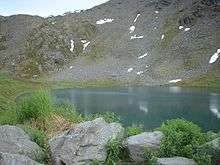Summit Lake (Willow, Alaska)
Summit Lake is a very small tarn (cirque lake) located above the tree line within the Hatcher Pass of the Talkeetna Mountains in Willow, Alaska, United States.
| Summit Lake | |
|---|---|
 A mid-summer view of Summit Lake | |
 Summit Lake Location of Summit Lake within the State of Alaska | |
| Location | Willow, Alaska United States |
| Coordinates | 61°45′58″N 149°19′16″W |
| Type | Natural lake |
| Part of | Susitna River Basin |
| Primary inflows | Snow fields & springs |
| Primary outflows | Willow Creek[Note 1] |
| Basin countries | United States |
| Managing agency | Alaska Department of Natural Resources: Division of Parks and Outdoor Recreation |
| Designation | State recreational site |
| Max. depth | 20 feet (6.1 m)[1] |
| Surface elevation | 3,600 feet (1,100 m)[1] |
Description

The lake is located about 2,000 feet (610 m) southwest of the summit of Hatcher Pass, about 2 miles (3.2 km) southwest of the Independence Mine State Historic Park, and about 2,500 feet (760 m) northwest of Hatch Peak. It is also about 26 miles (42 km) west of main area of Willow and about 12 miles (19 km) north of both Palmer and Wasilla. The lake is situated within (and is the namesake of) the Summit Lake Recreation Site[1] The lake is fed directly by springs and snow fields and flows via a waterfall into beginning of Willow Creek.[Note 1] Willow Creek feeds into the Susitna River, which empties into the Cook Inlet of the Gulf of Alaska.
While lake is very small, it is still a very popular site for photography.[2][3][4][5] In addition to the lake's very scenic views in the summer, the area is also a destination for hiking and paragliding. In winter, the area is also popular for backcountry winter sports and access to the area is maintained year-round. However, complete access through the pass (including access from Willow) is usually not possible until early July.[6] The lake itself is accessed from the gravel road by a wide, but short and fairly rocky trail.[7]
See also
Notes
- The Willow Creek (into which the Summit Lake drains) should not be confused with Willow Creek, Alaska, a census-designated place about 133 miles (214 km) east of Summit Lake.
References
- "Summit Lake State Recreation Site". dnr.alaska.gov. Alaska Department of Natural Resources: Division of Parks and Outdoor Recreation. Retrieved 26 Dec 2015.
- Day, Ron. "Alaska at Sunrise: The April Bowl Trail". rondayvous.com. Retrieved 30 Dec 2015.
- "Sunhusky's Alaska: Hatcher Pass - Summit Lake". sunhusky.blogspot.com. 9 Sep 2011. Retrieved 30 Dec 2015.
- "Hatcher Pass & Alpenglow Wedding: Julia & Adam". ericaroseblog.com. Erica Rose Photography. 22 Sep 2013. Retrieved 30 Dec 2015.
- Ylitalo, Emily (3 Aug 2013). "Summit Lake, Hatcher Pass". lifewithemilylillian.blogspot.com. Retrieved 30 Dec 2015.
- "Summit Lake State Recreation Area". Alaska.org. Alaska Channel. Retrieved 26 Dec 2015.
- "Summit Lake". doa.alaska.gov. Alaska Department of Administration. Retrieved 30 Dec 2015.
External links
- Summit Lake State Recreation Site (Alaska Department of Natural Resources: Division of Parks and Outdoor Recreation webpage)
- Summit Lake State Recreational Site (another Alaska Department of Natural Resources: Division of Parks and Outdoor Recreation webpage)
- Hatcher Pass East Management Area brochure
- Hatcher Pass, Alaska on Vimeo
- Summit Lake Alaska - Hatcher Pass Lake on YouTube
- The April Bowl Trail (Alaska at Sunrise blog page, by Ron Day)